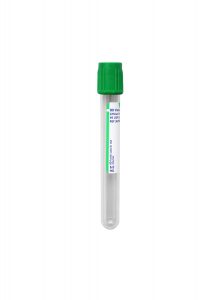Test Name
Prostate Specific Antigen, Diagnostic (PSA)
CPT Codes
84153
Methodology
Electro Chemiluminescence Immunoassay (ECLIA)
Turnaround Time
8 hours
Specimen Requirements
Type:
Plasma
Volume:
1 mL
Minimum Volume:
0.3 mL
Collection Container:
Green BD Hemogard™ Lithium Heparin Tube
Transport Temperature:
Refrigerated
Alternative Specimen Requirements
Type:
Serum
Volume:
1 mL
Minimum Volume:
0.3 mL
Collection Container:
Gold BD Hemogard™ Serum Separation Tubes (SST)™
Transport Temperature:
Refrigerated
Stability
Ambient:
24 hours
Refrigerated:
5 days
Frozen:
24 weeks
Additional Information
Background Information
Prostate-specific antigen (PSA) is a serine protease (~30kDa) secreted almost exclusively by prostate epithelial cells. PSA was first described in 1979 when it was detected in blood; the concentration of PSA was increased in cases of prostate cancer or other prostatic diseases, such as benign prostatic hyperplasia.[1]
Serum PSA measurement was shown to enhance early detection of prostate cancer, leading to the recognition of its potential as a screening test.[2] Serum PSA alone, or combined with a digital rectal exam (DRE), have been used in clinical trials for early detection of prostate cancer.[3-4] A recent multicenter-study using serum PSA tests with various cutoffs between 2.6 and 4.0 ng/ml showed a 20% reduction in prostate cancer-specific mortality.[4]
Limitations
PSA as a marker is only prostatic tissue-specific rather than cancer-specific. Increased PSA in serum was not only detected in patients with prostate cancer, but also in benign prostatic disease.[1] This phenomenon resulted in a significant false positive rate in PSA-based detection of prostate cancer based on biopsy results from those patients.
Additionally, PSA-based detection of prostate cancer often resulted in over-diagnosis of low-grade cancer that may have never become clinically significant. Several approaches to improve the distinction between cancer and benign conditions have been proposed, including the use of age-adjusted PSA reference ranges, PSA density, PSA velocity, and free-to-total PSA ratio.
Clinical Significance
The traditional cutoff for serum PSA is 4.0 ng/ml. PSA values >4.0 ng/mL were considered abnormal, and these patients were further evaluated with invasive diagnostic approaches, such as prostate biopsy or transrectal ultrasonography of the prostate.[1] However, multiple studies suggest that the risk of prostate cancer in men with PSA levels <4.0 ng/mL is significant (see Table 1). For example, the prostate cancer prevention trial (PCPT) included 2.950 participants who had PSA levels < 4.0 ng/mL and underwent an end-of-study biopsy. Results showed that more than 15% of these men had prostate cancer.[5]
The detection rate of prostate cancer is about 47% in men with serum PSA in the range of 4-10 ng/mL.[5] However, the cancer rate is very similar for men with a PSA range of 2.0-3.0 ng/mL(23%) and that with PSA of 3.0-4.0 ng/ml (26%).
Table 1. Likelihood of Cancer, Based on PSA Level
PSA (ng/mL)
≤ 1.0
1.1 – 2.0
2.1 – 3.0
3.1 – 4.0
4.1 – 10.0
> 10.0
Risk for Prostate Cancer on Biopsy
8.8%
17.0%
23.9%
26.9%
47.0%
58.2%
Data from the prostate cancer prevention trial demonstrated that there is no PSA level below which the risk of having prostate cancer is zero, and suggests that there is no “normal” reference range for PSA. The detection rate of prostate cancer is significantly correlated to the serum PSA levels.
Lowering the PSA cutoff of 4.0 ng/ml to 2.6 ng/ml would increase detection of prostate cancer, while also slightly increasing false positive results.[6-8]
Test Update Information
The new PSA reference range is 0-2.59 ng/ml; the upper limit is cutoff value for further evaluation.
The following comment will be included with each PSA result:
“For an individual patient, the significance of a PSA level should be interpreted in a broad clinical context, including age, race, family history, digital rectal examination, prostate size, results of prior testing (prostate biopsy, free PSA, PCA3), and use of 5-alpha-reductase inhibitors. Considering the high incidence of asymptomatic cancer in the general population that may not pose an ultimate risk to the patient, the decision to recommend urological evaluation or prostate biopsy should be individualized after considering all of these factors.”
A useful tool that incorporates many of these variables for calculating the risk of cancer is available at myprostatecancerrisk.com. This information may assist physicians in deciding whether a prostate biopsy is appropriate.
References
1. Cooner WH, Mosley BR, Rutherford CL, Jr. et al. Prostate cancer detection in a clinical urological practice by ultrasonography, digital rectal examination and prostate specific antigen. J Urol 1990;143:1146-52; discussion 1152-4.
2. Catalona WJ, Smith DS, Ratliff TL et al. Measurement of prostate-specific antigen in serum as a screening test for prostate cancer. N Engl J Med 1991;324:1156-61.
3. Andriole GL, Crawford ED, Grubb RL 3rd, Buys SS, Chia D et al. [PLCO Project Team]. Mortality results from a randomized prostate-cancer screening trial. N Engl J Med. 2009;360(13):1310-9.
4. Schröder FH, Hugosson J, Roobol MJ et al. ERSPC Investigators. Screening and prostate-cancer mortality in a randomized European study. N Engl J Med. 2009;360(13):1320-8.
5. Thompson IM, Pauler DK, Goodman PJ et al. Prevalence of prostate cancer among men with a prostate-specific antigen level < or =4.0 ng per milliliter. N Engl J Med. 2004;350:2239-46.
6. Catalona WJ, Smith DS, Ornstein DK. Prostate cancer detection in men with serum PSA concentrations of 2.6 to 4.0 ng/mL and benign prostate examination. Enhancement of specificity with free PSA measurements. JAMA. 1997;277(18):1452-5.
7. Müntener M, Kunz U, Eichler K et al. Lowering the PSA threshold for prostate biopsy from 4 to 2.5 ng/ml: influence on cancer characteristics and number of men needed to biopsy. Urol Int. 2010;84(2):141-6.
8. Punglia RS, D’Amico AV, Catalona WJ, Roehl KA, Kuntz KM. Effect of verification bias on screening for prostate cancer by measurement of prostate-specific antigen. N Engl J Med. 2003 Jul 24;349(4):335-42.


